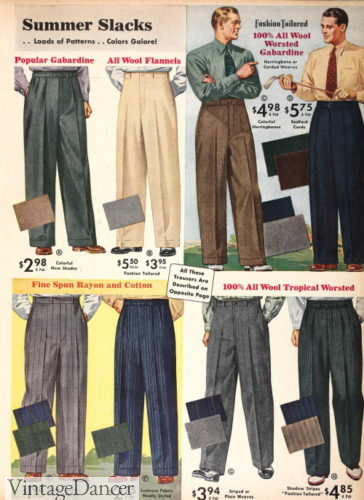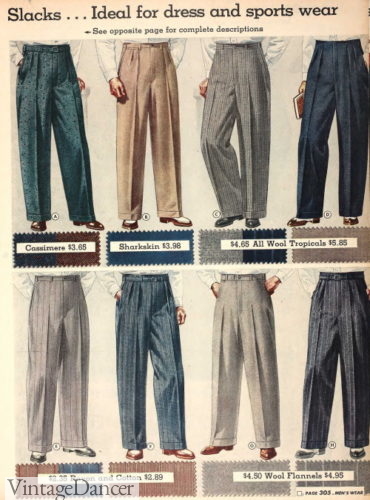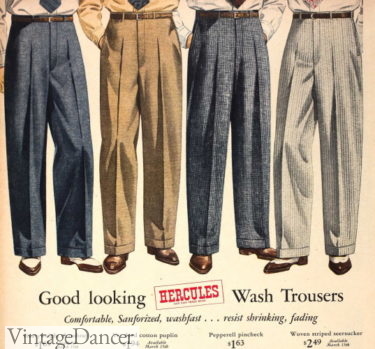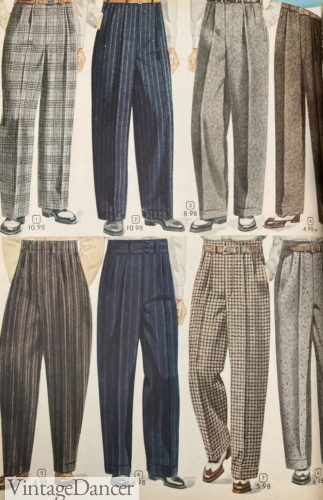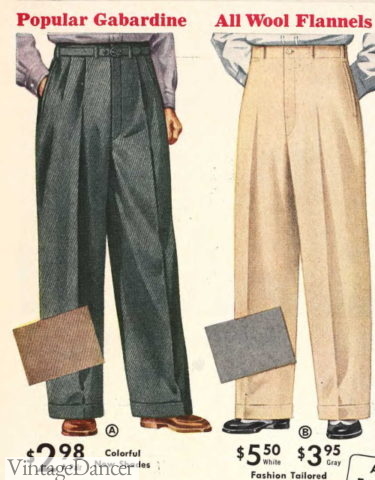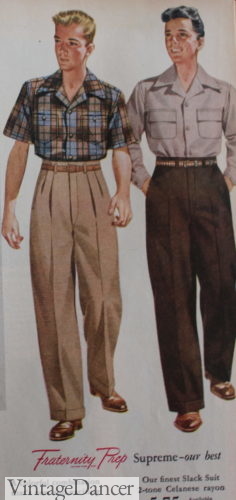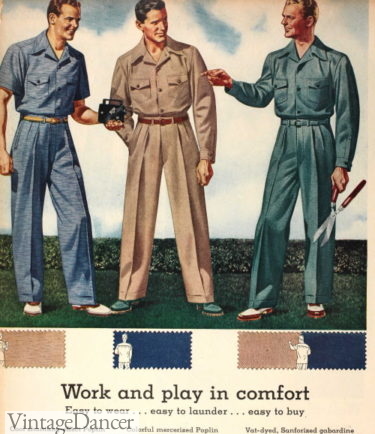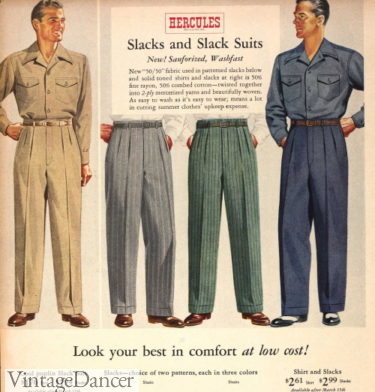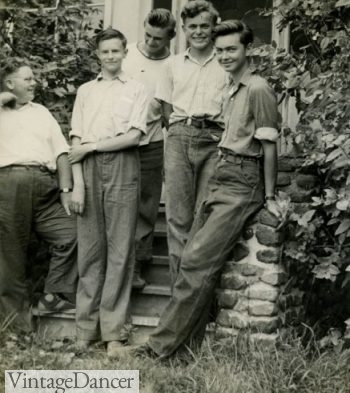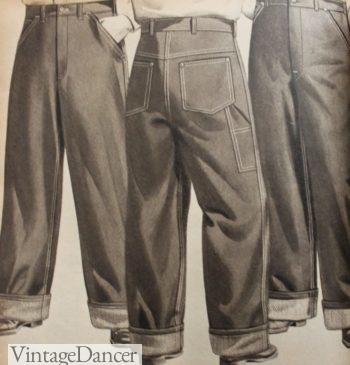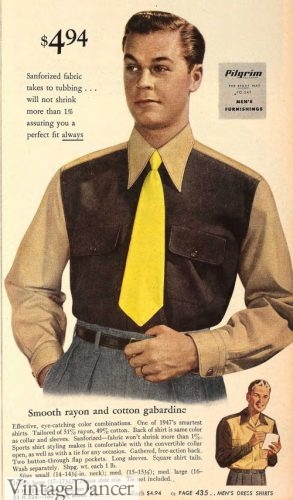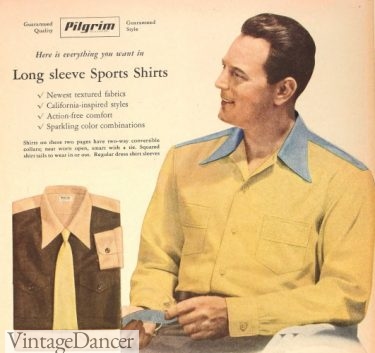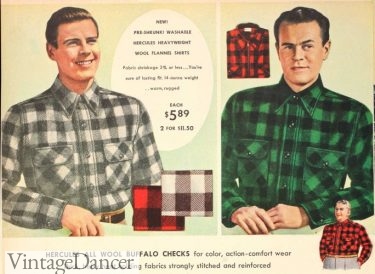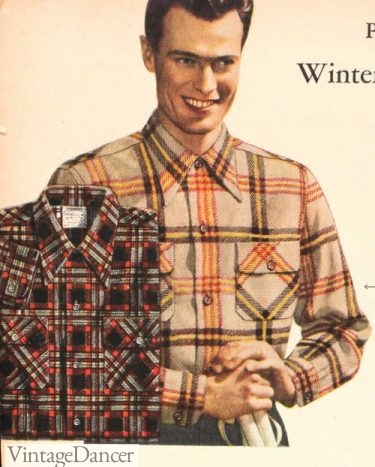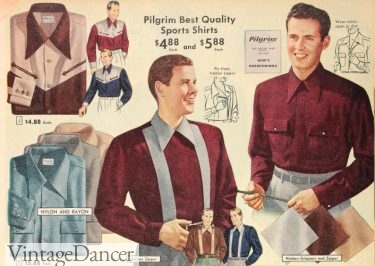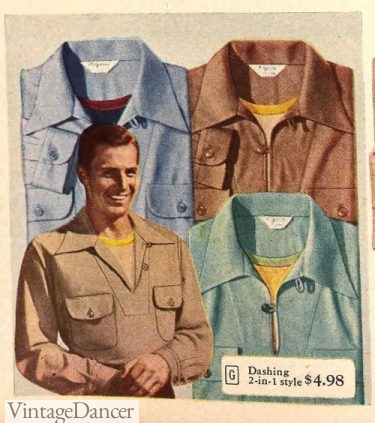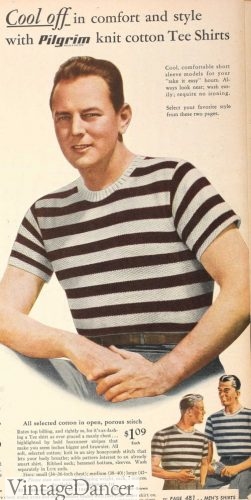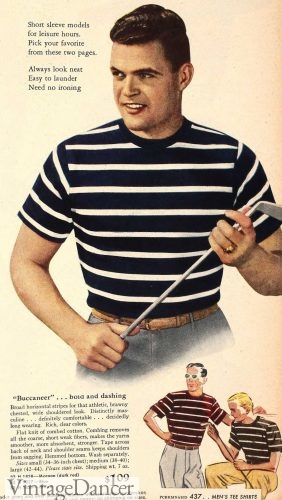While men’s 1940s business attire moved toward formality, casual style went the opposite way. Ease and comfort blended the lighter business suit style with sports wear established in the previous decades. This merging resulted in sports coats instead of business suits, relaxed button up shirts in new colors, and an explosion of popularity in knitwear during this decade. 1940s men’s casual clothing looks formal to us today, yet many of our modern favorites took root during this time, such as denim jeans, T-shirts, and Hawaiian shirts. Without these inventions, where would our style be today?
1940s Sport Coats
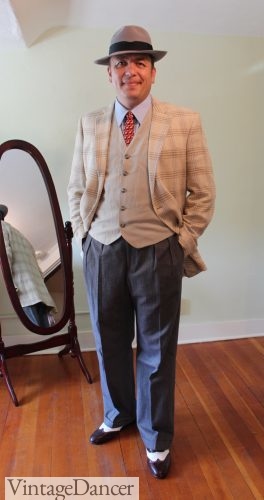
1940s Sportcoat (light) and vest, over dark trousers, two tone shoes and a grey fedora hat.
Sport coats were a newer trend that gained popularity in the 1930s. They, too, came in a smattering of Glen plaids, herringbone, chevron checks, and chalk stripes. In the early 1940s, Shetland and tweed remained popular in the 4 button model with leather elbow patches. The newer 3 button notch lapel sport coat was an increasingly popular style because it looked more relaxed and less conservative. The fit slimmed down as well into a nicely tailored coat that had lost much of the “drape” look of the 1930s.
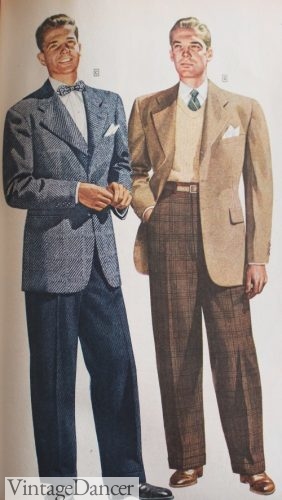
1944 Young Men’s Sport Coats
Sport coats were worn with solid colored pants that were darker than the sport coat, with the exception of white pants, which were primarily worn with a navy blue sport coat. Military tan pants were especially common and coordinated well with all sport coat colors. Most sport coats had wide rounded notch lapels and two very large square pockets that were either flap, slit, or patch styles.
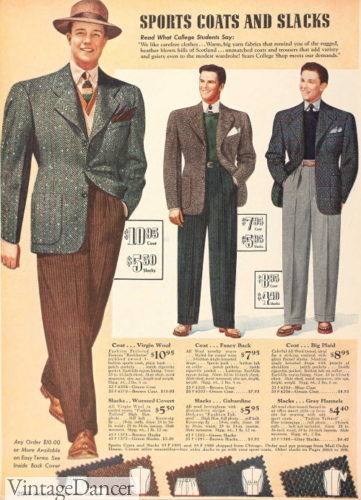
1940 Sportcoat Fall Outfits
The 1942 War Production Board restricted patch pockets, pleats, belts, and vents on sport coats. The limited access to wool also meant coats were being made of alternative fabrics such as tweed, flannel, and synthetic blends. A limitation in available colors produced a bland, military inspired color palette.
After the war, men’s sport coats were the first to throw off drabness and minimalism. Patch pockets returned even bigger, patterns were bolder, and colors were no wear near Army tan.
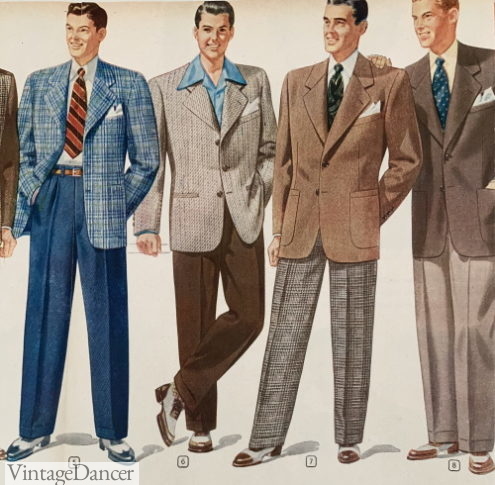
1948 sportcoat slacksuits
The bush jacket, common in the early 1930s, returned in a hip-length style complete with 4 pleated patch pockets and an extra wide collar. It was made of colored flannel instead of the previous light cotton tan. On many jackets, buttons were replaced by the zipper. Fashionable men wore these summer bush coats with Indian madras walking shorts (knee length) or casual flannel sacks and a foulard scarf.
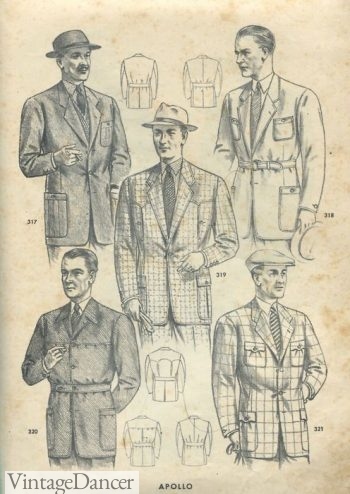
1940s Sporty Bush Jackets
By the mid to late ’40s, the influence of California fashion was felt around the world. The sports coat loosened up even more around the waist to an almost straight line from shoulder to hip. Prints and textures increased, as did vibrant colors reflecting the bright and cheerful California sunshine. Newer fabrics gabardine, twill, and flannel were lighter and smoother for a polished look.
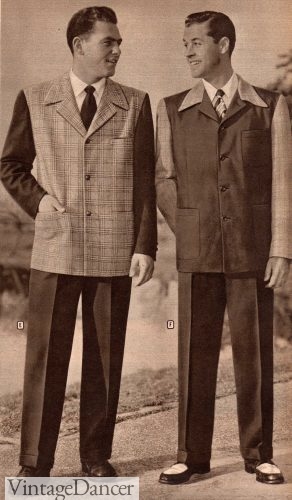
1947 Solid and Print Mixed Sport Coats
Blending solids and patterns also emerged in the late 1940s. It wasn’t uncommon to wear a sport coat with a solid front body with plaid or check print arms and back. Western influence was also seen in a yoke design around the chest and shoulders. By 1948, the new Bold Look was in place. It had men wearing wide lapels, broad shoulders, and big patterns. Corduroy and seersucker fabrics contributed to this period of confident casualness.
Read more about the bold look and 1950s men’s casual fashions.
Shop men’s 1940s style suits and sportscoats.
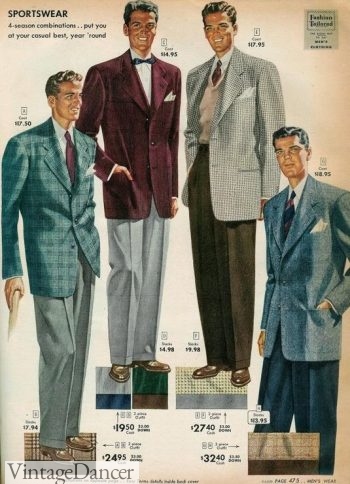
Men’s 1949 The Bold Look with Colorful Sport Coats
1940s Men’s Casual Trousers
Trousers, now renamed as slacks (slacksuits), were sold separately from suits and were worn for casual day wear, sporting events, and some work environments. They were a bit more colorful and comfortable than suit trousers, made of lighter weight wool blends in the cooler months and even lighter cotton poplins, flannel, gabardine (rayon blend), and seersucker for tropical climates.
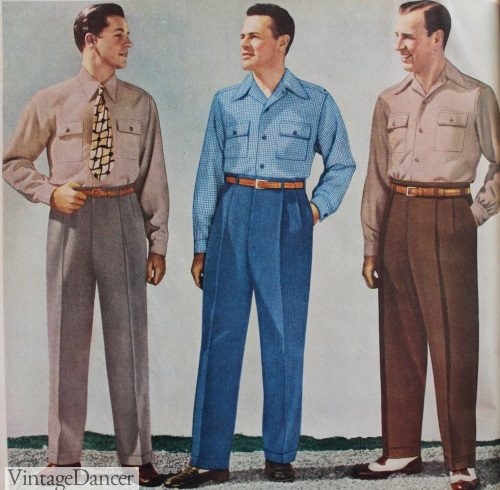
1947 Men’s Casual Clothing– Slacks and Shirts
Solid colors of green, grey, blue, brown, and tan were staples, while more unique patterns like plaid, pinstripes, diagonal stripes, pin check, and herringbone in medium blues, maroons, and browns were favored. The California influence was seen in new colors such as russet, bright yellow, gold, and a blue-green.
- 1941 Men’s Summer Slacks
- 1942 Men’s Slacks
- 1946 Washable Trousers
- 1948 Casual or Dressy Slacks
Casual trousers featured a narrowed high waist and full hips with wide legs. Flat fronts and double pleats were equally popular. Waistbands had dropped belt loops, which always had a thin leather belt worn with them.
- 1941 Pleated Gabardine and Flat Flannel
- 1944 Young Men’s Casual Pants – Pleated and Flat
Shirts were worn tucked in, exposing the pants fully. Shirts rarely matched the pants with the exception of slacksuits designated for work or at home chore clothes. Instead, tan pants paired with maroon shirts, green plaid with brown, pinstripes with blue, etc.
Learn more about men’s 1940s working class pants, slacks and breeches (knickers and jodphur pants).
- 1942 Slacksuits with Matching Shirts
- 1946 Casual Slacksuits
Tip: For your casual outfit, focus on a good pair of high waisted, wide legged pants. Add a coordinating casual button down shirt or knit T shirt in the same color family (blues with blue, tan with brown, etc.) If you want brighter colors, try blue trousers with a yellow shirt, brown trousers with a green shirt, or green trousers with a khaki tan shirt. Add a thin leather belt and a pair of two tone oxford shoes.

1940s Men’s Casual Outfit with Wide Leg Trousers, Open Collar Shirt, Belt, Cap, and Two-Tone Shoes
Denim Jeans
The other type of casual pant was the blue jean. They were made for heavy duty work wear, but were quickly adopted for home work in the Victory Garden. Country men wore them as part of their Western style. Teens (even girls) wore them as the uniform of their generation.
- 1940s Teens in Blue Jeans
- 1942 Plain Back Denim Jeans
1940s denim jeans were high waisted with a long crotch and wide legs that folded up. They had large patch pockets on the back and deep side pockets. The denim was always a dark wash.
During the war years, rivets were removed, decorative top stitching was removed or painted on, and the adjustable back strap disappeared for good.
Shop men’s 1940s style denim jeans.
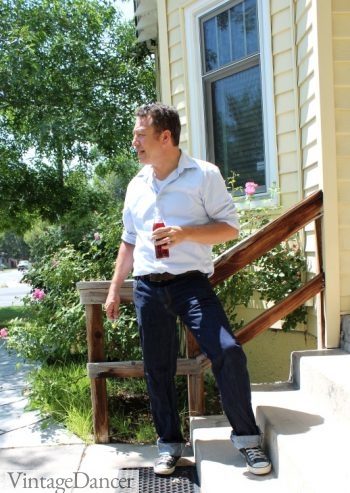
1940s-1950s Vintage Men’s Casual Jeans, Converse Shoes, and Rolled Sleeve Shirt
1940s Men’s Shorts
With the exception of gym shorts and swim trunks, men did not wear shorts going into the 1940s. By the middle years, however, shorts were frequently being worn in hot climates. This new line of “walk shorts” took men’s trousers and cut off the legs at the knee.
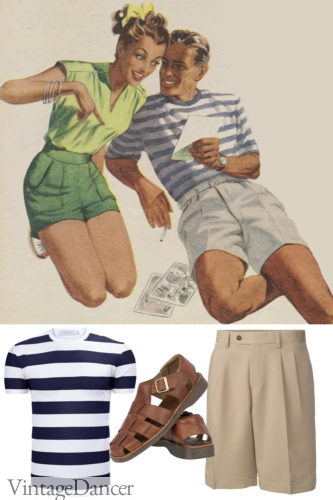
1940s Shorts Outfit with Stripe T-Shirt and Fisherman Style Sandals (Socks Optional)
1940s men’s shorts had a pleated waistband and a long just-above-the-knee length. They were worn with a belt, casual shirt (knit shirt or polo), tall over-the-calf socks, and casual shoes. Fisherman type sandals could also we worn with socks!
Shop men’s vintage style shorts.
1940s Casual Button Down Shirts
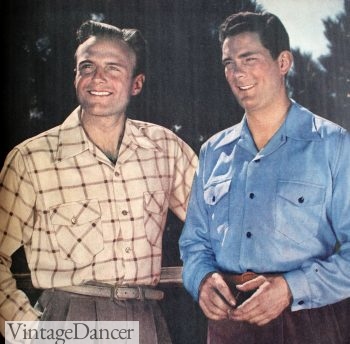
1943 Men’s Casual Shirts with Sport Collars
The businessman’s dress shirt had a counterpart in the button down sport shirt. The look was nearly identical, but the casual shirt had a wide, soft, pointed collar. The other style was the sport collar, which had an extra wide point collar that flared out towards the armpit with a smaller notch beneath. This created a small V opening– a much more breathable and relaxed style. Both collar styles were equally popular among men.
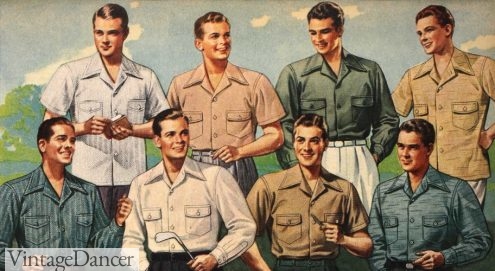
1941 Men’s Casual Shirts
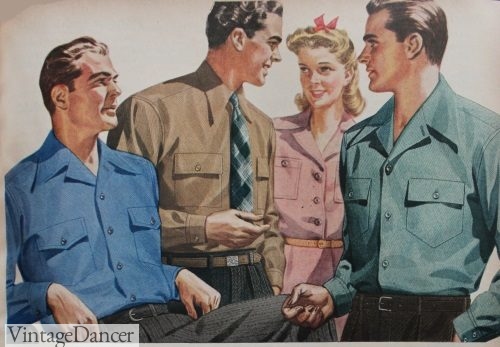
1942 Men’s Casual Shirts with the Two Collar Types
Solid colors of cotton twill or rayon made casual shirts light yet durable. Shirts had boxy long sleeves and were straight cut along the bottom. They had two chest pockets that came in welt, button, or fold-over flaps. Colors could be plain tan, brown, blue, green, or maroon with prints of large plaid, check, windowpane, or vertical stripes.
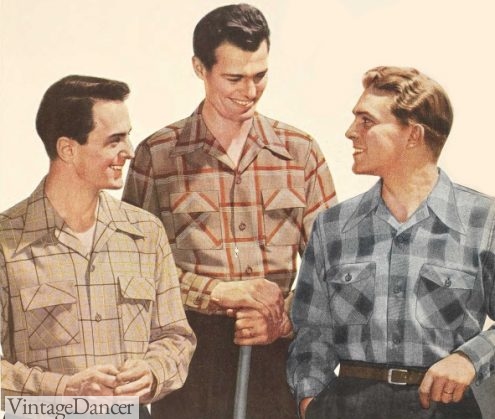
1943 Men’s Sport Shirts of Windowpane and Plaid
One particular color pattern in the late 1950s was the colorblock, or two-tone pattern. Sleeves and backs were made in contrasting colors to the front shirt body, or the shirt front with sleeves contrasted with the back and collar. Some advertising called this the “California sport shirt.”
Most sport shirts or casual shirts were long sleeved. If men became too hot, they simply rolled up the sleeves to the elbow and unbutton the top collar button. There were, however, some short sleeve sport shirts, usually targeting the active sportsman. These became more common going into the 1950s. Learn more about men’s 1940s shirt styles.
Shop men’s 1940s style shirts.
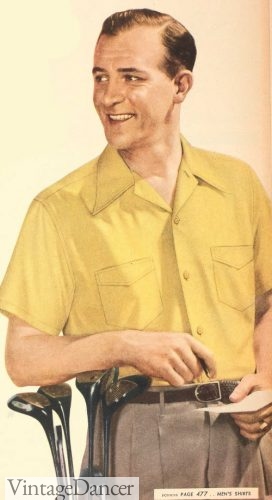
1946 Short Sleeved Sport Shirt
Winter Shirts
In winter, plaid shirts were favored above all other prints. They could be made of a heavy flannel, cotton twill, or suede cloth. They had two flap pockets and a button up classic collar. Solid colors were made, too, but plaid was the best choice. Pendleton still makes plaid shirts from their 1940s/1950s patterns.
Learn more about these and other men’s workwear shirts here.
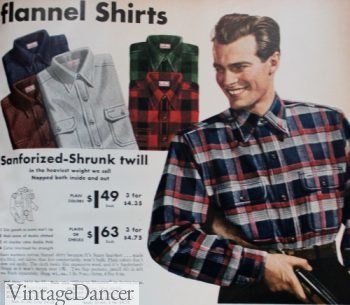
Men’s Cotton Twill and Plaid Flannel Sport Shirts
- 1948 Buffalo Plaid Shirts
- 1943 Plaid Winter Shirts
Hawaiian Shirts
The Hawaiian ‘Aloha’ shirt — featuring hand painted tropical scenes, birds and flowers — was introduced after the war. They had a sport collar and were worn untucked with a loose, boxy fit. Most had the classic two chest pockets, but some tropical prints only had one pocket. They were usually made of a light cotton or rayon. They were established as tourist shirts prior to the 1940s, but after the war, men who were stationed or passed through remembered the natural beauty of the islands fondly.
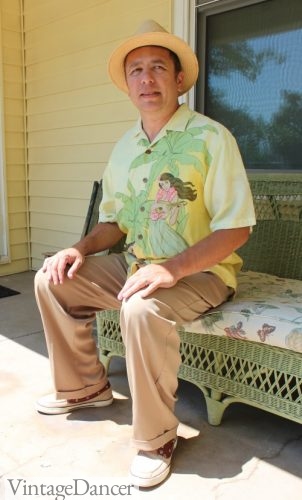
1940s Inspired Hawaiian Style (Shirt is a Newer Tommy Bahama brand)
Men returned to the area as tourists, or at least bought up souvenir Aloha shirts to remember their experience. Native Hawaiians who no longer had access to overseas clothing began wearing the shirts, too.
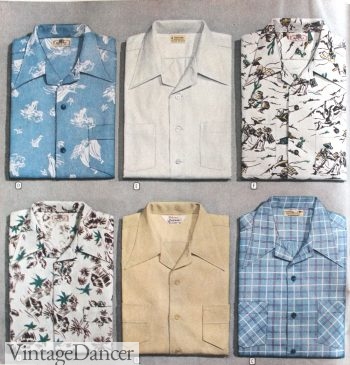
1947 Tropical Prints and Colors
The fad for the re-named Hawaiian shirt was propelled forward even more when in 1953 the movie From Here to Eternity depicted the lead characters wearing Hawaiian shirts as they responded to the Pearl Harbor bombing. After that, the Hawaiian shirt became famous.
Western Shirts
“The 1940s-50s became known as a Golden Age of Western shirts, based not only on the popularity of the new style, but also on the sheer artistry and construction that went into many of the production shirts. Snaps and yokes would remain stylish signatures of Western shirts, but embroidery and fancy pocket treatments all but disappeared until the 1980 movie Urban Cowboy revived interest in elaborate details. “ — 100 Years of Western Wear by Tyler Beard, Jim Arndt
Hollywood’s wave of American Western movies spawned an interest in western style clothing for boys and men. Western shirts, hats, boots and trousers were popular equally with city and country folk. You could say that the Urban cowboy began in the 1940s.
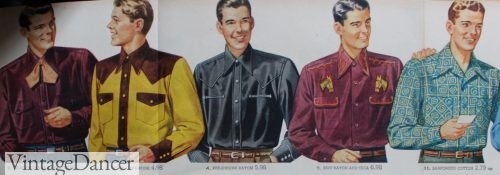
1948 Western Shirts
The western shirt was another casual shirt style. It has the same high button up collar as dress shirts, although some western prints were made into casual shirts with sport collars. Western shirts had yokes with piped lines or contrasted two color combinations. A western knot tie or bolo tie was a frequent accessory.
The yoke detail inspired several sport shirt designs that blended well into non-western shirts. These are sometimes called Gaucho shirts, although there is a lack of a clear definition of what a Gaucho style really is.
Learn more about vintage men’s western wear.
- 1949 Colorblock Yoke Front Sport Shirts
- 1948 Yoke Front and Loop Button Collar Sport Shirts
Knit Shirts and T-Shirts
Some form of knit shirt has existed since the 1920s. The 1940s knit sport shirt came in solid, wide vertical stripes (the fisherman look) and fun novelty prints and designs.
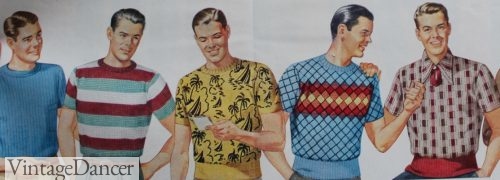
1948 Men’s Knit Shirts
The knits were textured, not smooth, like a short sleeve sweater with a small ribbed crew neck. Some shirts also had arm bands. The waist of the shirt was short (pants were high) with a wide 4-6 inch band that was either worn tucked into pants or worn on top (teenagers). They fit very snug– hello muscles!
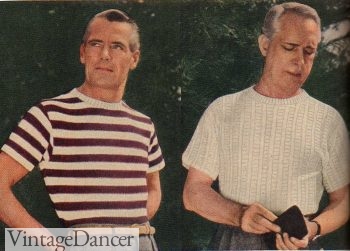
1944 Men’s Knit T-Shirts
The striped knit shirt, or T shirt, is perhaps the best lifetime contribution to men’s fashion from the 1940s. Vertical striped shirts, sometimes with contrasting “ringer” neckbands, were a summer shirt essential.
Nautical colors (red or blue with white) were the classic pairings while maroon, grey, yellow, and brown made an updated look. Both wide and very thin stripes shirt were worn, as well as various thicknesses from smooth flat weaves to textured open weave knits. Some shirt had a small pocket on the chest.
- 1946 Maroon and Grey Striped Knit Shirt
- 1947 Blue and White Stripe Shirt
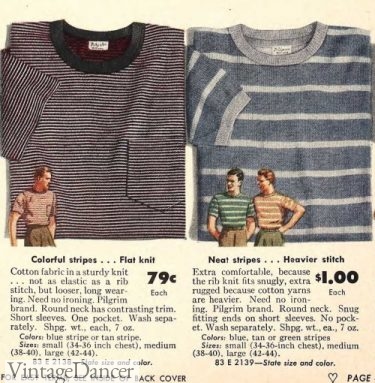
1943, Thin or Medium-Wide Stripes
Of the knit shirts and T shirt, the novelty pattern shirt is my favorite. Designers had a lot of fun coming up with new patterns and color combinations. Diamond plaid, accordion, ladder, cable, Fair Isle, jacquard, zip-zag, and chains were a few of the pattern descriptions.
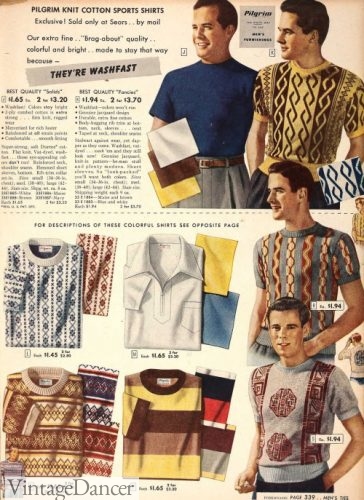
1949 Knit Shirts with Novelty Patterns
The polo shirt was another pique cotton shirt with a soft knit collar. Genuine white polo shirts had a button-up 1/4 length opening, while later styles were simply pullover knits with a soft collar. It was a very popular shirt in the 1930s but lost favor in the 1940s, only to come back again in the 1950s.
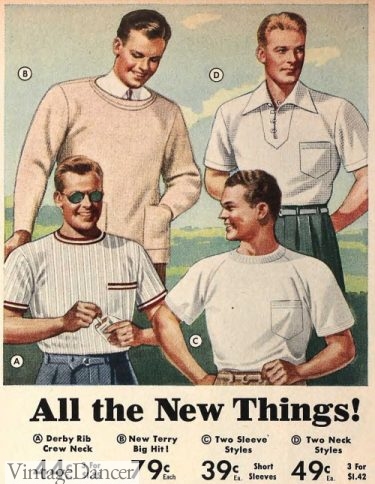
1941 Polo Shirts and T-Shirts
During the war, servicemen were assigned smooth white undershirts to be worn underneath uniforms. These comfortable cotton knit shirts were worn off duty, and when the war was over, men continued to wear them as casual attire, sport clothing and gym clothes.
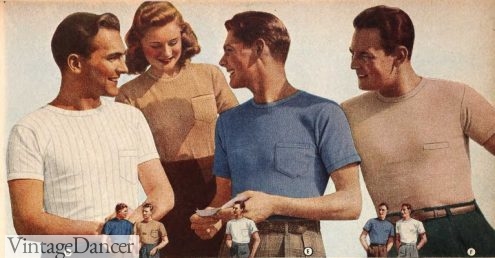
1943 Sport or Casual T-Shirts
It was still taboo to wear them in public, but at home, anything goes. Retailers designed a similar smooth knit T-shirt that was more appropriate for sports attire. It could either be a round crew neck or small V-neck in plain white, tan or blue. It fit a little looser than knit shirts, much like T-shirts today.
Shop men’s 1940s knit shirts and T-shirts and learn more about men’s 1940s shirt styles.
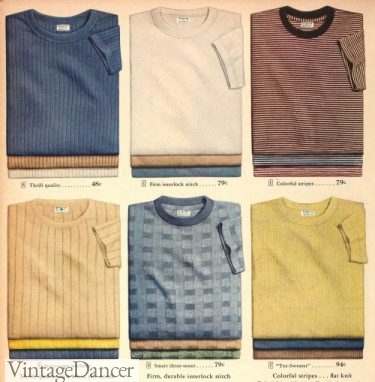
1946 T shirts- Ribbed, Plaid, Striped, and Weaved
Tip: Knitted shirts are coming back in fashion. The best selection is available in the fall and early spring. When you can’t find a heavy knitted shirt, a jersey T-shirt with a ringer crew neckband will work fine. Size down for a snug 40s fit. Shop shirts.
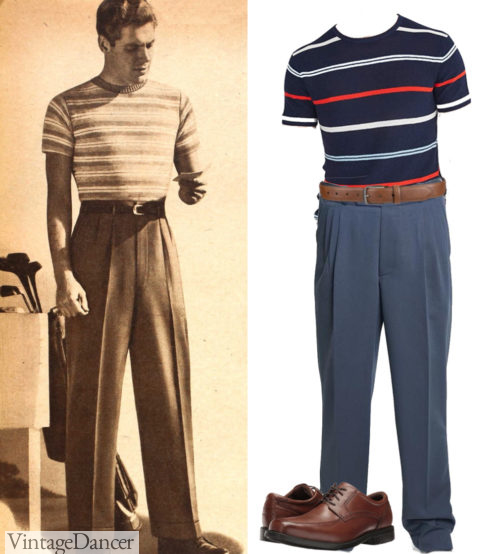
1940s Men’s Casual Outfit with Pants, Striped T-Shirt, Belt, and Moc Toe Shoes
Sweater Vests
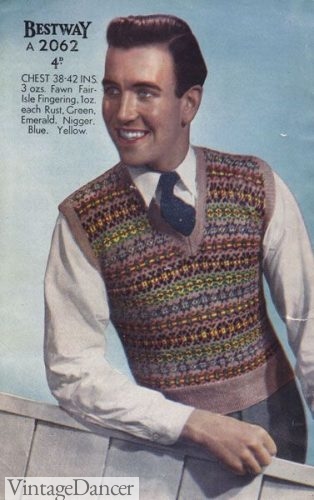
1940s Men’s Fair Isle Sweater Vest
The final piece of causal clothing for men in the 1940s was the V-neck sweater vest. Usually, a cool-weather layer was was worn on top of casual button up shirts with a sport coat and tie. For some sports, like tennis and golf, the sweater vest became part of the uniformed look despite the heat.
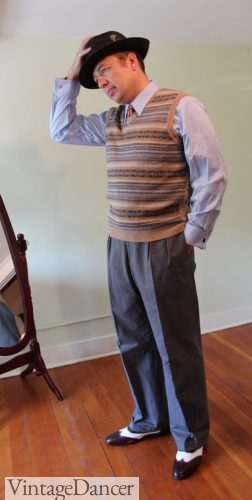
A Pullover Vest Creates an Ideal 1940s Casual Style
V-neck pullover vests were wool knits for extra warmth in winter, and knit with rayon/cotton blends in summer. Pullovers usually contrasted with the shirts underneath and the trousers, creating a very colorful outfit. For example, you might see a tan shirt with green slacks and a blue vest, or a wine colored shirt with navy pants and a grey vest.
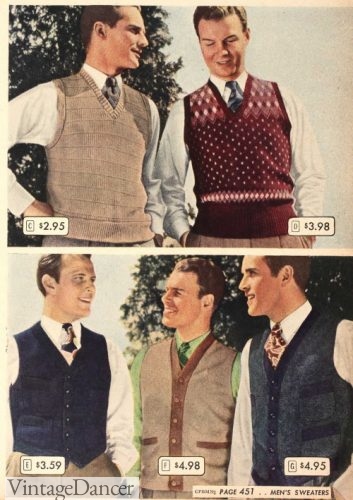
1944 Sweater Vests and Cardigan Vests
Many sweater vests had traditional patterns such as Fair Isle, checks, argyle, and stripes. Plain color vests were hardly ever boring with the use of cable stitching, large ribs, and other knitted textures. Some had a contrasting color binding around the neck and arm holes.
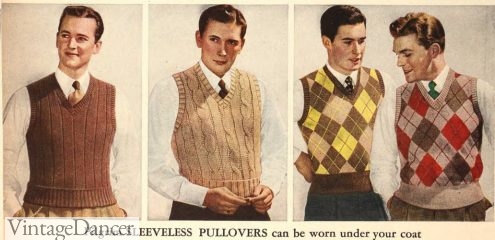
1943 Sweater Vests
A sweater vest could be button-up, like a sleeveless cardigan sweater. They could also not be knit at all. Instead, wearing a suit vest with sport shirt and coat was an option, and one that was common during the war years when clothing was limited.
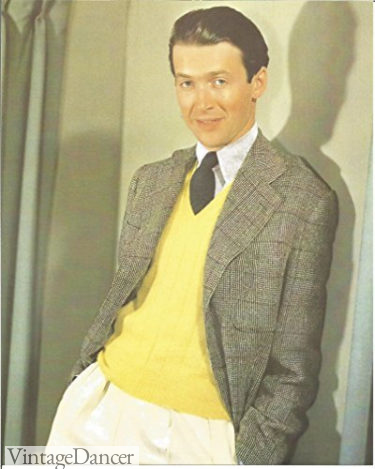
Jimmy Stewart Wearing a 1940s Yellow Knit Vest, Sport Coat, and Cream Trousers
All Together Now – Men’s Casual Clothing
For your own 1940s inspired look, you can use genuine vintage clothing, reproduction clothing, or vintage inspired new clothes.
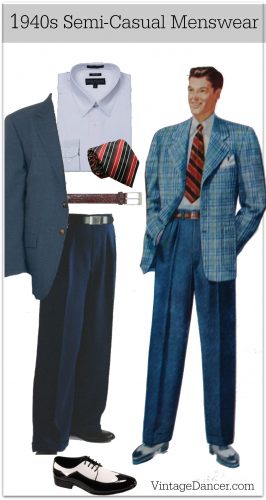
1940s Casual Men’s Clothing– Sportcoat, Casual Shirt, Tie, Belt, and Shoes
- Sportcoat in solid or better big pattern – Plaid, checks, stripes. Ideally, lapels should be wide and have two large patch pockets. Many vintage ’70s and ’80s sport coats look ’40s.
- Sport shirt or casual dress shirt. Choose a solid white, light blue, cream or yellow if your coat has a pattern.
- (Optional) Suit vest or sweater vest.
- Tie – Bold stripes, geometric or a hand painted vintage wide ties look best. Consider including a pocket square for a semi-formal look.
- Thin leather brown belt.
- Wide leg, high waist, single or double pleat pants in blue, brown, grey in solid or pattern prints.
- Shoes – two tone Oxfords look the most casual.
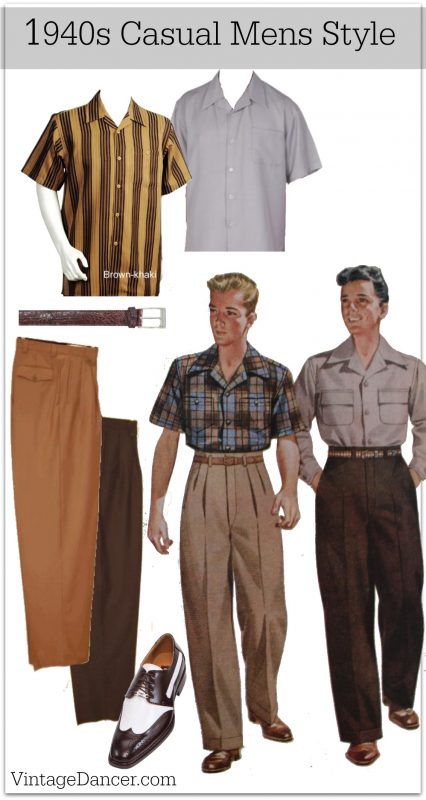
1940s Men’s Casual Clothing – Sport Shirts and Pants
- Sport shirt with open sport collar/camp collar shirt/revere collar shirt, Hawaiian shirt, western shirt, spearpoint collar shirt (long sleeve). Worn tucked into trouser waistband.
- Wide leg pants, solid color. Pleated or flat front. Cuffed at the ankles.
- Thin leather brown belt.
- Shoes – Two tone Oxfords, solid brown Oxfords, penny loafers, or moc toe shoes.
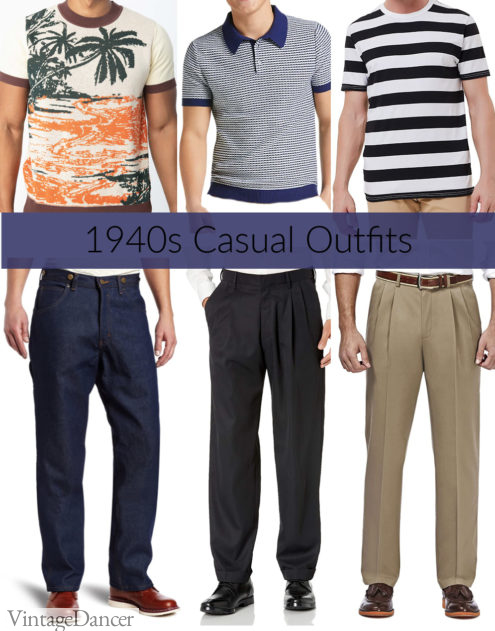
1940s Men’s Casual Outfits with Knit Shirts/T-Shirts and Pants or Jeans
- Knit shirt (pullover), knit polo shirt, or stripe ringer T-shirt. Worn either tucked in or untucked.
- Wide leg pants in a solid color or dark denim blue jeans.
- Thin leather belt.
- Shoes – Loafers, mocs, boat shoes.
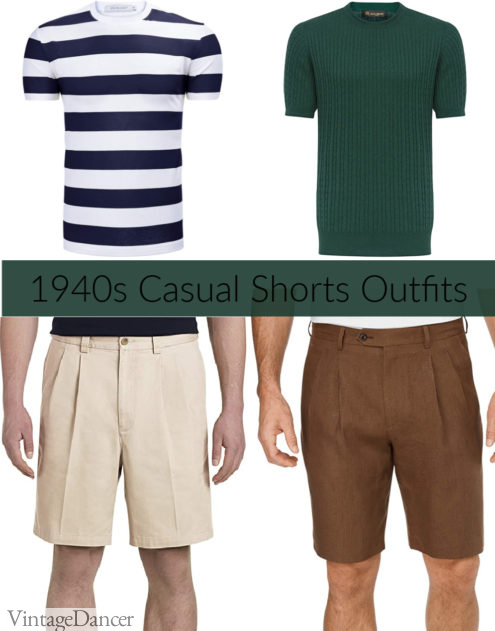
Short and T-shirts (Knit Shirts)
- Knit shirt or stripe T-shirt. Worn tucked in.
- Pleated long shorts or swim trunks/ gym shorts.
- Thin leather belt.
- Shoes – Loafers, boat shoes, fisherman sandals. Worn with mid calf socks (white).
Explore more 1940s men’s outfit ideas and men’s casual vintage styles here.
Read More
- 1950s Men’s Casual Clothing History
- 1930s Men’s Casual Fashion History
- Vintage Men’s Swimsuits History
- 1940s Mens Sunglasses and Eyeglasses
Debbie Sessions has been teaching fashion history and helping people dress for vintage themed events since 2009. She has turned a hobby into VintageDancer.com with hundreds of well researched articles and hand picked links to vintage inspired clothing online. She aims to make dressing accurately (or not) an affordable option for all. Oh, and she dances too.
